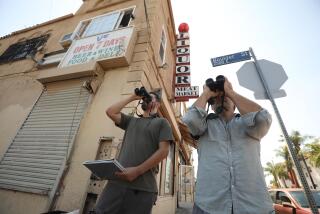The City of Light Leaves Its Suburbs in the Dark
- Share via
PARIS — While parents in chic Parisian neighborhoods worry about college admissions, parents in the tough suburb of Bondy temporarily pulled their kids out of junior high school last year after a wave of violence in the hallways.
While the Paris mayor is encouraging people to clean up after their dogs, people who live outside city limits are more concerned about attacks by pit bulls, the breed of choice among suburban youths.
The Paris known for its history and beauty is the Paris of the 20 districts, or arrondissements, built around the Seine River. But it’s a different story in some of the 500 communities in the shadow of the City of Light.
In the United States, suburbs are identified with Little League games and backyard barbecues. In Paris, suburbia often is associated with gang violence, high unemployment and bad schools where kids are brutally bullied and scores are settled with exploding bottles of gas.
“It’s a shame, but here’s the stereotype: The city is where all the good things happen, and the suburbs are where all the bad things happen,” said Bouba Thiam, an 18-year-old raising money in Paris to send suburban kids to summer camp.
About 9.6 million people live in greater Paris, according to U.N. figures, most of them in the suburbs, especially the vast housing projects of the eastern and northern suburbs. These were built after World War II as temporary homes for immigrants, many from North Africa, who came to work in automobile factories.
“It bothers me that Paris is France’s showcase,” said Anne Closmadeuc, a 31-year-old sculptor and lifelong Parisian. “We give the world an image of France that’s all about luxury and comfort, while we know full well that there are people here who are having a rough time.”
Paris has gone from 11th biggest city in the world in 1980 to 21st today, according to the U.N. figures in a report for Habitat II, last week’s special U.N. session on the state of the world’s cities.
It remains a huge tourist destination--26 million visitors last year --and the French spend a lot of energy and money to preserve the beauty of their capital. A 15-year project to repair the city’s historic bridges will cost $114 million, while a six-year program to wipe out graffiti has a $72-million price tag.
Paris has a difficult task--preserving its history while staying dynamic and attractive to young people, said Michel Micheau, director of the urban planning program at the prestigious Institut d’Etudes Politiques.
“The key question for politicians is, how can we prevent Paris from becoming a museum?” Micheau said. “We don’t want Paris to become Venice.”
He says city officials are trying to lure new residents, especially young families, with more leisure and cultural activities open to everyone, even those with little money to spend. On Sundays the city closes the quays of the Seine to traffic, opening them to rollerbladers and bikers. Big-name afternoon jazz concerts at the Parc Floral charge only about $1.50 a ticket.
Other efforts to diversify Paris include offering low-rent apartments in a city where incomes average 43% more than in the provinces, and the tiniest apartment can cost $535 a month. France passed a law last year that would increase the percentage of subsidized housing in urban areas to 20% within 20 years.
In some areas, especially in chic western Paris, residents have mounted opposition to the plans, worried about crime and other social problems intruding into their neighborhoods.
Another great divider is public transportation. Paris’ subway system works well if you live in the arrondissements but is not well linked to the suburban network. It’s as though New York City were to have one network for Manhattan, another for Brooklyn and Queens.
Les Halles, once the city meat market, now home of the Beaubourg museum, is one of the few areas in Paris where kids from the suburbs hang out alongside tourists and Parisians. Its Chatelet station is the entry point for many who take the train into the city.
During the day, Les Halles’ latticed gardens and pedestrian malls are a bustling meeting place for young people from both inside and outside the city. Teenage boys in baggy pants pass out fliers for a nightclub, while high-school girls nibble ice cream cones and read magazines.
In the evening, many Parisians, fearing crime, avoid the area. Police cars patrol the gardens, sometimes asking loiterers to leave.
“It’s nice here,” said Steve Fort, an 18-year-old suburban high-schooler, relaxing with friends. “It’s a change from the suburbs.”
More to Read
Sign up for Essential California
The most important California stories and recommendations in your inbox every morning.
You may occasionally receive promotional content from the Los Angeles Times.













